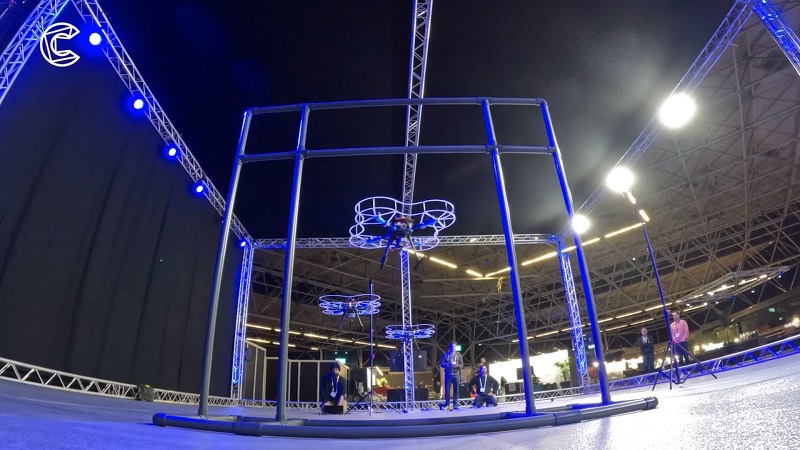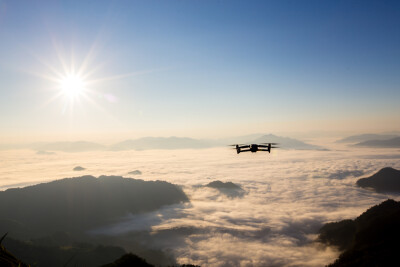Many hands make light work (properly coordinated hands that is). This timeless truism is the essence of why I  believe collaborative autonomous drone fleets with a dynamic hierarchy of command and control will help ambitious companies seize the future. It’s also the focus of a technological breakthrough we’ve made at Cambridge Consultants, but more on that later.
believe collaborative autonomous drone fleets with a dynamic hierarchy of command and control will help ambitious companies seize the future. It’s also the focus of a technological breakthrough we’ve made at Cambridge Consultants, but more on that later.
I’d like to start with my view that commercial drone operations have reached a pivotal point. The UAVs themselves are maturing, along with key systems infrastructure such as traffic management. So too is the potency of initial breakthrough use cases like data collection and infrastructure / asset inspection.
However, the current economics of operations are mostly based on uncrewed aircraft systems (UAS) missions using individual semi-autonomous drones with autopilot and supervision from a human operator in the loop. While this model of homogenous drones working independently is set to transform many industries, the full commercial value can be unlocked with the efficiency gains, adaptability and scalability that multi-drone operations enable. Concurrently, the industry is urgently working to accelerate public and regulatory acceptance of UAVs.
I want to provide an update on our vision of a collaborative autonomous fleet model that would transform economic viability and societal acceptance. With oversight from a single human operator (on the loop), more would be achieved in less time – with improved reliability and safely. This is a concept I first talked about in Commercial UAV News last year.
It’s this backdrop that subsequently spurred our multidisciplinary team of scientists, engineers and designers to develop a unique working fleet of collaborative autonomous drones. After a busy 12 months, a proof-of-concept demo of this technology is now up and running in our lab, providing a unique foundational technology to offer our clients and opening the door to Level 5 autonomy (the highest possible) and beyond visual line of sight (BVLOS) capability.
To learn more about our research and to see film of the live demonstration, you can download our new paper - “Collaborative autonomous drone fleets for next-level UAS operations”.
We developed an indoor lab to provide a more controlled environment for experiments. Custom made drones give us an airframe and a modular onboard computing and communication system that can be fully controlled remotely. Our indoor location tracking system provides UAV positions with millimetre accuracy.
Early feedback from industry suggests many use cases can be achieved more effectivity with multiple drones, which demonstrate a cognitive collaboration with the ability to self-organize. Infrastructure asset inspection using thermal cameras, smart farming and search and rescue are all ideal candidates due to the ability of autonomous fleets allowing missions to become:
- More efficient, because multiple UAVs can cover a greater area or a larger physical linear asset
- More resilient, because the mission can be completed if one of the member of the fleet is compromised (the fleet can provide a mesh for communications and control)
- More effective, because the payload and mission activity for each UAV in the fleet can be different and complementary (each can have a unique sensor to execute a different task)
- Safer, because autonomy removes the human element that is subject to error, inconsistency and bias
However, we understand that not every UAV use case will need BVLOS and full autonomy. The collaborative fleet approach is another tool in the toolkit to be used in appropriate situations and use cases. UAVs working in hostile places such as offshore wind farms are great for removing the danger of crewed aircraft. But an autonomous, pilotless police drone investigating a crime scene has too much of the dystopian nature of the ‘I Robot’ movie for most of us. All autonomous systems should augment human effort, remove burden, ease complex, repetitive and dangerous tasks – and ultimately deliver end user convenience and elevate the value of human endeavour.
Our development work on this project is continuing, and I look forward to sharing more insights in the coming months. I’m truly excited to push the boundaries of autonomy that answers the challenges and opportunities of safe and successful flights that commercial operators require. Please don’t hesitate to drop me an email if you would like to learn more.
This article summarises key aspects from Cambridge Consultants latest whitepaper - "Collaborative autonomous drone fleets for next-level UAS operations”. Download a free copy here .
About the author Christopher Bourbeau, VP of North America Aerospace at Cambridge Consultants, helps companies achieve complex breakthroughs through the intersection of innovation, end-user requirements, and commercial opportunity. He has 25 years+ of defence and commercial aerospace experience; from serving on the front-line of land, air, sea, and space, to developing business strategies for major companies. Chris holds an MBA and BSc in Technology Information Systems Management.
Christopher Bourbeau, VP of North America Aerospace at Cambridge Consultants, helps companies achieve complex breakthroughs through the intersection of innovation, end-user requirements, and commercial opportunity. He has 25 years+ of defence and commercial aerospace experience; from serving on the front-line of land, air, sea, and space, to developing business strategies for major companies. Chris holds an MBA and BSc in Technology Information Systems Management.
















Comments